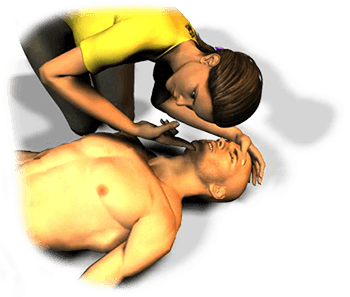Online CPR/AED/First-Aid Class
Triage - Determine type and severity of the problem
Before providing first aid, you need to assess the ill or injured person in order to find out what the problem is.
- ● Check to see if they are responsive. Tap and shout “are you okay?” If they are unresponsive, check to see if they are breathing
- ● If they are breathing and don’t need immediate first aid, check for any obvious signs of injury, such as bleeding, burns, broken bones, or bite marks
- ● Look for any medical information jewelry to see if they have any serious medical conditions
Then take the following steps for finding the problem.
- ● Make sure the scene is safe.
- ● Check to see if the person responds. Approach them, tap on them, and shout “Are you okay?”
If the victim is responsive
- ● Ask them what the problem is.
- ● If they only move and moan, but can’t form coherent words, shout for help. Call 9-1-1 or send someone else to do it, and get the first aid kit or AED.
- ● Look for the obvious signs of injury.
- ● Look for medical information jewelry to find out if they have any serious conditions.
If the victim is unresponsive
Shout for help and phone 9-1-1
- ● If someone else is available, have them call for help and get the first aid kit and AED
- ● If you’re alone but have a cell phone, call 9-1-1 and put it on speaker so that you can listen to the dispatcher’s instructions while you provide care. You will have to get the first aid kit and AED yourself
Check for breathing.
- ● If they are breathing normally, stay with them until help arrives. Check for injuries and medical information jewelry
- ● If they aren’t breathing normally, or are only gasping for air, begin CPR and use an AED
- ● Let advanced help take over when it arrives
Using Caution When Moving an Ill or Injured Person
In most cases, you should not move someone when giving first aid. This is especially important if you think they may have a pelvic or spinal injury.
Only move the victim when:
- ● If the area is unsafe. You should move them to a safer place before giving aid.
- ● If the person is unresponsive and breathing normally, you may roll them onto their side. By doing so, you may keep their airway open in case they vomit.
If possible, grab them by the clothes while moving them to safety.
Protecting the Victim’s Privacy
As a first aid responder, you may learn private things about some of the people you help, such as medical conditions. Generally, the only people you should tell about this are the EMS rescuers, who need to know in order to do their jobs properly. If you are in your workplace, you may also need to give this information to your supervisor.
Do not share private information with friends, coworkers, or anyone who doesn’t need to know.
If you work in the healthcare industry, you may also be bound by HIPAA laws and policies.
|
